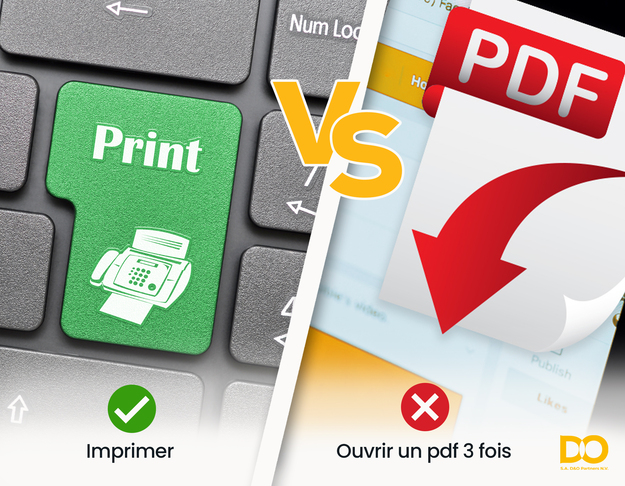The transition from paper to digital has long been marked by the slogan “Goodbye paper, save the trees”, indicating that the digital format is more respectful of the environment. However, the complexity of the lifecycle of electronic devices, from production to disposal, online storage and access to information, now reveals a significant environmental impact. The idea that digital technology is automatically the “green solution” of choice is now being challenged, especially as paper offers advantages specific to the physical format, such as its ability to contribute to CO2 storage. Rather than proposing a return to the past, D&O Partners, Xerox dealer in Brussels, invites you to analyze the advantages and disadvantages of paper and digital to determine their respective usefulness.
The pros and cons of paper and digital
The comparison between the two sectors depends on three main parameters of their respective life cycles: the production process, use and end-of-life.
The digital sector
Today, the real impact of digital technology on the environment can no longer be overlooked. Greenhouse gas emissions from this sector fall into three main categories: data centers (25%), network infrastructures (28%) and consumer devices such as laptops, smartphones, tablets and other connected objects (47%).
These emissions result from several phases, including production (mineral extraction, component transformation, distribution), use (power supply) and end-of-life of devices (recycling and destruction of materials). Although the use phase has the lowest GHG emissions, it is still significant. For example, this phase accounts for about 6% of the total emissions from a smartphone, 11% from a laptop and 33% from a television set, with respective lifetimes of 2, 4 and 5 years.
The biggest drawback of digital technology is the inadequate recycling of end-of-life waste electrical and electronic equipment. The amount of waste is growing three times faster than the world’s population, and 90% of it is disposed of illegally. In 2019, 54 million tons of waste were produced, equivalent to 7.3 kg per inhabitant of the planet. In addition to the precious metals contained in these devices, they also contain highly toxic substances. The precious metals are often mined by children and women in developing countries. This semi-recycling process is often more harmful to both the people who recover the waste and the environment, for example, when workers burn computers to extract the copper.
On the other hand, this process stands out for its relentless ease of use, offering easy access to information, the ability to quickly navigate through thousands of archives and unquestionable speed.
The paper sector
The true carbon footprint of paper is largely measured during production and transportation to the converting plant. Greenhouse gas emissions during this process vary widely, depending on forest management and the origin of the paper. Although most of the paper we use comes from Europe, some of the pulp we use comes from other continents and high-risk areas, such as Brazil. Thanks to practices such as cogeneration (combined production of heat and electricity) and the use of pulp production residues (such as wood chips or bark), the industry has significantly reduced its greenhouse gas emissions. Between 2005 and 2015, the energy required to produce a ton of paper was halved. Despite this, paper production is the industry’s biggest weakness because it requires a lot of forest and fresh water.
When it comes to printing, while the act itself has a negligible energy impact (order of magnitude <0.001 kg CO2 / page), it is important to emphasize that printers do have an impact on the environment, divided between metal extraction, assembly and transportation.
The biggest advantage of paper is its durability. Unlike digital media, which are prone to defects or piracy, paper, if stored properly, can be preserved and remain accessible for a very long time. In addition, a sheet of paper can be recycled up to seven times. Maximum recycling can reduce CO2 emissions by 47%. Europe currently recycles more than 70% of its paper, a figure comparable worldwide.
How do you make your choice?
When weighing the pros and cons of the two formats, the optimal choice depends largely on the specific use. In general, the more often you use a document, the more interesting the paper format becomes. This is because the carbon footprint of electronic devices increases the longer they are used, while paper emissions remain stable after printing. It should also be noted that every time a digital document is accessed, CO2 is emitted due to the energy consumed by the reading device and the data center where the information sought is hosted. It is generally considered better to print a document if you plan to consult it more than three times. For one-time consultations, digital has less environmental impact, although storing data in data centers for long periods of time also contributes to emissions, again highlighting the challenges of digital sustainability.
However, it is necessary to emphasize that the judicious use of these technologies also has important positive impacts. Moreover, a phone kept for 10 years has a much smaller ecological impact than one replaced every two years. Finally, recycling devices partially reduces their emissions, underscoring the importance of proper waste management.
And what about the future?
Reducing the environmental impact of the two sectors depends largely on improving the recycling process to significantly reduce the waste produced.
However, if we assume an ideal situation where we manage to recycle everything, paper seems to have an additional advantage. While the ability to reduce the carbon footprint of an electronic device stagnates at a theoretical 100% recycling rate, paper offers a different perspective by helping to improve the overall carbon footprint through temporary storage of carbon. By turning trees into paper, CO2 that would otherwise be released into the atmosphere when burned is temporarily sequestered. A study at a Chinese paper mill found that when the carbon storage capacity of paper was included in a life cycle assessment (LCA), emissions decreased by 24% over a 30-year period.
By combining this storage capacity with the paper industry’s ability to increase natural capital through reforestation, the paper industry has the potential to become climate-positive and a major player in the fight against climate change.
Conclusion
The choice between paper and digital depends very much on the context. However, it is possible to identify certain general principles. Maximizing the lifespan of devices (smartphones, computers, televisions, but also printers), recycling correctly and minimizing energy consumption are essential practices. Then there are emissions: even if we imagine that one day we will have 100% recycled materials, the use of electronic devices will continue to produce greenhouse gases, even if to a lesser extent. So if you plan to consult a document regularly (3 or 4 times), paper is the most sustainable solution, while digital is preferable for a one-time reading.

